BKO "President-S": export supplies and possible use
About the beginning of export deliveries of the airborne defense complex (BSO) "President-C" 13 October reported the publication "News". Information about the contract for the sale of new equipment to a foreign customer was received from an unnamed representative of the military and diplomatic circles. An anonymous source revealed the buyer, and also spoke about some of the features of the transaction and the current status of the acquired systems. So, to date, the delivered protection systems have already been installed on military helicopters.
According to an unnamed source "Izvestia", Egypt became the first foreign customer of the BKO "President-S", which has recently shown great interest in Russian weapons and military equipment. The first batch of three products was transferred to the customer at the end of this summer. Since then, Egyptian specialists have managed to install new equipment on the Mi-17 multi-purpose helicopters that are currently in service. One of the additionally equipped cars has already been shown to the general public. October 6 This helicopter was involved in the parade dedicated to the anniversary of the beginning of the “Doomsday War”.
It is reported that three helicopters with airborne defense complexes have already managed to take part not only in commemorations, but also in real combat operations. This technique performed various tasks during recent operations, the purpose of which was to fight terrorists. The unnamed source "Izvestia" has no information about the details of the use of the upgraded technology. Whether Mi-17 and SBO "President-S" came under fire from those or other anti-aircraft weapons is unknown. At the same time, it is argued that the customer was satisfied with the new acquisition.
Izvestia writes that the aircraft defense complex supplied to Egypt is the export version of the Vitebsk L-370 system. The equipment of the Russian Aerospace Forces is currently being equipped with similar means of protection. The task of the BKO “President-S” is to monitor the surrounding space and detect potential risks. When detecting the launch of an anti-aircraft missile, the automatics must use suitable means of protection that do not allow the enemy ammunition to hit the aircraft.

Active jamming station. Photo Research Institute "Screen" / Niiekran.ru
According to reports, the BKO "President-S" was put into series in the middle of last year. The release of serial defense complexes allowed the deployment of modernization of combat aircraft. Protection systems of the new type are received by airplanes and helicopters of the special flying squad “Russia”, working with state leaders, as well as by the equipment of the Aerospace Forces. Such equipment should be received by various VKS machines, including military transport planes and helicopters, attack helicopters, as well as other equipment, the combat work of which implies an increased risk of destruction by enemy anti-aircraft weapons. According to the existing data, a certain amount of aircraft equipped with the “President-S” complex is currently used as part of a group operating in Syria.
A few days ago in the domestic press and on specialized resources there appeared assumptions about the possible fact of using the Presidential SKO armored personnel carrier under conditions of a real combat operation. However, these assumptions have not yet received official confirmation. According to the military, the difficult situation in which the defense complex was allegedly used was resolved with the help of other means of defense against attack.
October 8 The Russian Center for Reconciliation of the Warring Parties in Syria announced an attempt to destroy the helicopter of the Russian Aerospace Forces. One of the Russian Mi-8 helicopters was involved in the transport of humanitarian aid in the province of Hama. The cargo was accompanied by several officers of the Center of reconciliation of the parties. Around 11: 00 Moscow time, the helicopter came under rocket attack from the ground using a man-portable air defense system. The rocket passed by a helicopter and, having developed an engine charge, self-destructed. The helicopter, its crew, cargo and accompanying did not suffer.
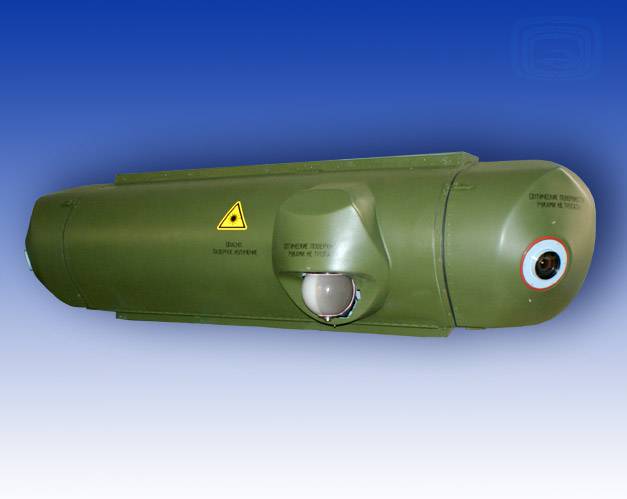
One of the variants of the laser station opto-electronic suppression. Photo Research Institute "Screen" / Niiekran.ru
According to the official report of the Reconciliation Center, the rocket’s entry into the helicopter was avoided due to the flight altitude gained, timely launch detection, and crew skills. Thus, having noticed the launch in time, the crew managed to take measures, due to which the rocket could not hit the target. In addition, the high altitude of the helicopter, which significantly reduced the missile capabilities, apparently contributed to avoiding the attack.
Also, representatives of the Russian military department indicated that the 6 of October from the territory of Iraq to the territory of Syria were transported by terrorists to two portable anti-aircraft complexes. These products are supposed to be used in the suburbs of Hama in order to cover armed groups trying to take control of the road to Aleppo.
Soon publications appeared in several domestic editions, suggesting a slightly different development of events in the skies over Hama. Taking into account the experience of previous “collisions” of helicopters with portable air defense missiles, it is assumed that the real reasons for saving the Mi-8 from an enemy missile may differ from those mentioned by officials. There is a version according to which the decisive factor in the current situation was the onboard defense complex installed on the Russian helicopter.
Indeed, the system "President-S" was originally developed, first of all, to protect helicopters and airplanes from the attack of enemy adversaries. To solve such problems in its composition there are several special units. As a result, a terrorist rocket could theoretically be knocked off by an onboard defense complex, which did not allow her to successfully aim at the target and cause her any damage. The impact of the onboard defense complex could have prevented the correct operation of the homing head. In this case, we can talk about the means of optical-electronic countermeasures that interfere with the normal operation of the rocket using high-power directional radiation.
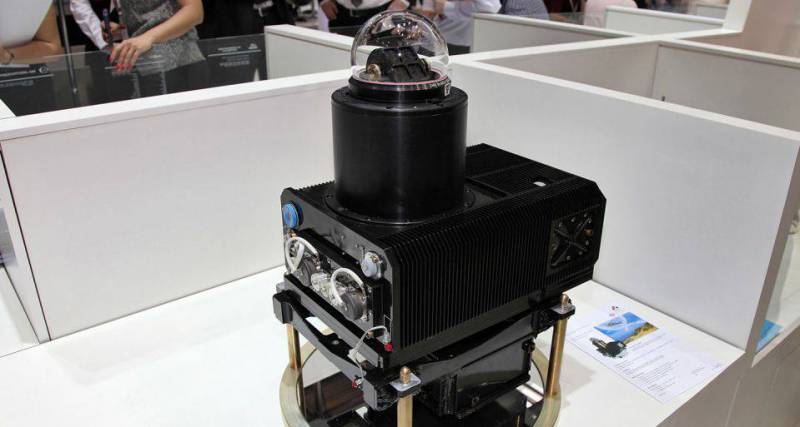
Another version of the laser station, demonstrated at the exhibitions of the last time. Photo Nevskii-bastion.ru
However, the version on the use of the BKO "President-S" has not yet received any serious confirmation. It is based on a number of assumptions and assumptions directly related to known facts. At the same time, officials do not report on the use of complex defense. According to the Reconciliation Center, in whose interests the helicopter worked, the enemy’s attack was disrupted by the high altitude of the flight, the timely detection of the threat and the skill of the pilots. In the current situation and taking into account the available facts, the official version is the only acceptable one. The assumption of the use of protective equipment is of particular interest, but still can not be considered as a complete description of the situation.
It should be noted that part of the aviation technology used in Syria bears onboard defense systems of new types, however, confirmed information about their use in real combat operations has not yet been received. Despite this fact, airplanes and helicopters of the Russian Aerospace Forces still have the means of protection against possible attacks from the ground. Thanks to this, the survivability of the combat mission and, as a result, its effectiveness is increased.
BKO "President-S" is one of the latest developments of the "Radioelectronic Technologies" concern. According to available data, the creation of a defense complex began in the middle of the last decade, taking into account the experience of recent local conflicts. The wars in Afghanistan and Chechnya have shown that illegal armed groups may have access to man-portable air defense systems, which, if used properly, pose a great danger to combat aircraft. The aim of the new project was to create a promising system capable of protecting aircraft and helicopters from anti-aircraft and aircraft missiles or enemy artillery systems.
The development of the “President-S” complex was carried out by several enterprises that are part of the “Radioelectronic Technologies” concern. The lead developer was the Scientific Research Institute "Ekran" (Samara). In addition, other organizations were involved in the project as performers of certain works. In 2010, the prototype of the new BKO was first presented at Eurosatory-2010 (France). In the future, “President-S” was repeatedly demonstrated at various exhibitions. After completing all the necessary tests, the complex was recommended for operation on aircraft. In the middle of last year, the concern-developer established the serial production of systems intended for installation on existing and new equipment.
The structure of the BKO "President-S" includes a set of various components for various purposes, which are responsible for the performance of certain tasks. The joint operation of all elements of the complex ensures the monitoring of the situation and the detection of rocket launches with the subsequent opposition to their correct targeting. The complex includes a control unit, radar, laser and rocket attack warning stations. There are also ejecting devices for shooting off several types of aviation expendables, radio and optical jamming stations. The latter have the possibility of exposure to the rocket incoherent noise or laser radiation. The complex may also include a towed radar trap, suspended on pylons under the wing or fuselage.
The defense complex is able to independently monitor the situation using a set of available sensors. Irradiation warning tools are designed to detect enemy radar or laser weapons, the use of which indicates the impending attack. The missile attack warning station, in turn, confirms the use of weapons by detecting a missile launch. In accordance with the parameters of the detected threat, the automation of the complex selects countermeasures appropriate to its type.
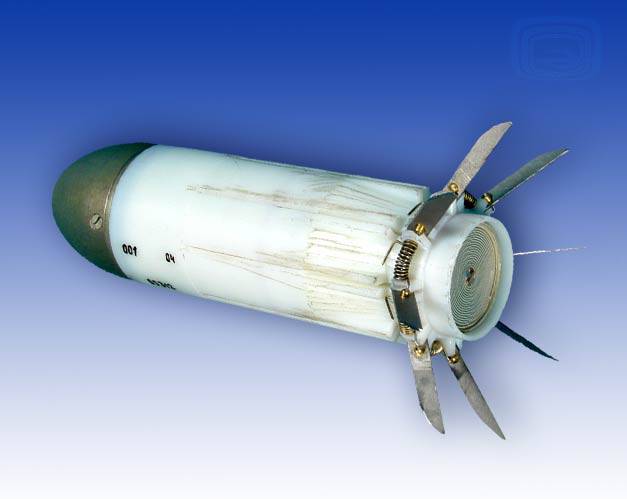
Single-use interference transmitter. Photo Research Institute "Screen" / Niiekran.ru
When the enemy uses radar-guided missiles or radars that control anti-aircraft artillery, it is proposed to use an active jamming station (SAP). This device is capable of simultaneously suppressing up to four radio-electronic means, located in a sector of width 120 ° in azimuth and 60 ° in elevation. The formulation of the main types of interference in the ranges from G to J is ensured. The own weight of the SAP - more than 51 kg.
Another means of dealing with radar equipment is the so-called. single-use interference transmitters (PDI). This device is a recoverable ammunition with a set of its own electronic equipment and on-board power source. After a carrier is shot off, the PSI can, during 6 seconds, broadcast interference interfering with the operation of the equipment of the attacking missile.
On the pylon of the aircraft carrier can be suspended so-called. active towed radar trap (ADBL). Externally, a rocket-like device with a mass of 5 kg can release a special block on a cable with means simulating a reflected signal from an aircraft. ADBL can be removed from the carrier at a distance of up to 150 m. Protection is provided against missiles with radar GOS in the sector from + 60 ° to -60 ° in azimuth and from + 22,5 ° to -22,5 ° in both the front and rear hemispheres.
Counteraction with infrared GOS is carried out using “traditional” false thermal targets, as well as using optical-electronic suppression stations. Incoherent suppression station (SOEP) is a block that generates powerful radiation and interferes with the normal operation of the rocket.
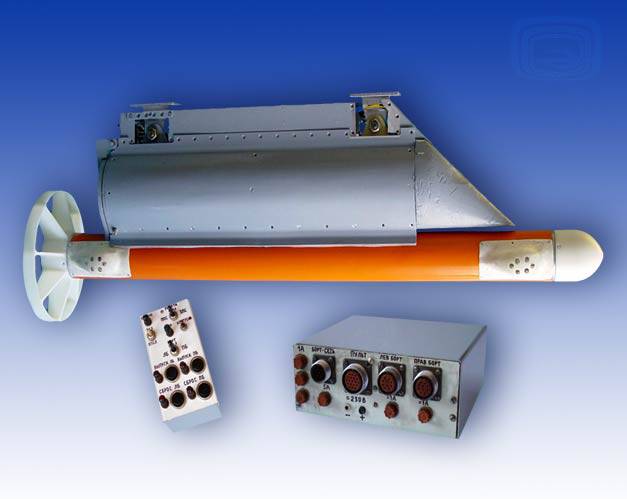
Active towed radar trap. Photo Research Institute "Screen" / Niiekran.ru
A more sophisticated means of suppressing infrared homing heads is an optical-electronic suppression laser station (LISEP). A station weighing no more than 150 kg is equipped with a laser with the required characteristics, as well as its guidance drives, control systems, etc. During operation, the mechanisms should direct the laser beam at the GOS of the rocket, due to which it loses the possibility of normal functioning or fails. Automation LSOEP able to capture the reflected laser radiation, confirming the suppression of the target. LSOEP complex "President-S" is capable of consistently suppressing at least two rockets simultaneously attacking from different directions. A “shot” with a laser beam in any direction in a sector with a range of elevation angles 90 ° is provided. The range is from 500 to 5000 m.
BKO "President-S" is performed in the form of a complex consisting of a set of individual components. Various equipment of the complex can be mounted both in the internal compartments of the carrier and on the external surface. The modular design to some extent simplifies the revision of the aircraft or the helicopter carrier to install the required equipment. At the request of the customer, the complex can be supplemented with a multifunctional indicator that displays information on the operation of the systems, as well as a matching device. The latter is intended to communicate and exchange information with other onboard carrier systems. Uses standard interfaces and data transfer algorithms.
Since last year, the airborne defense complex “President-S” has been serially manufactured and installed on aircraft of the Russian armed forces and special aviation structures. Equipped with a complex of aircraft and helicopters have the ability to protect themselves from attacks with the use of various weapons. Provides resistance to radar detection and guidance, as well as infrared homing heads. This makes it possible to count on effective counteraction against the overwhelming majority of possible threats. According to reports, Russian planes and helicopters operating in Syria are equipped with the President-S complex. In addition, a few days ago there was an assumption about the possible first combat use of this system. Similar news did not receive official confirmation, but the enemy should remember that new attempts to attack Russian equipment will be thwarted by onboard defense complexes.
On the materials of the sites:
http://izvestia.ru/
http://interfax.ru/
http://tvzvezda.ru/
http://niiekran.ru/
http://nevskii-bastion.ru/
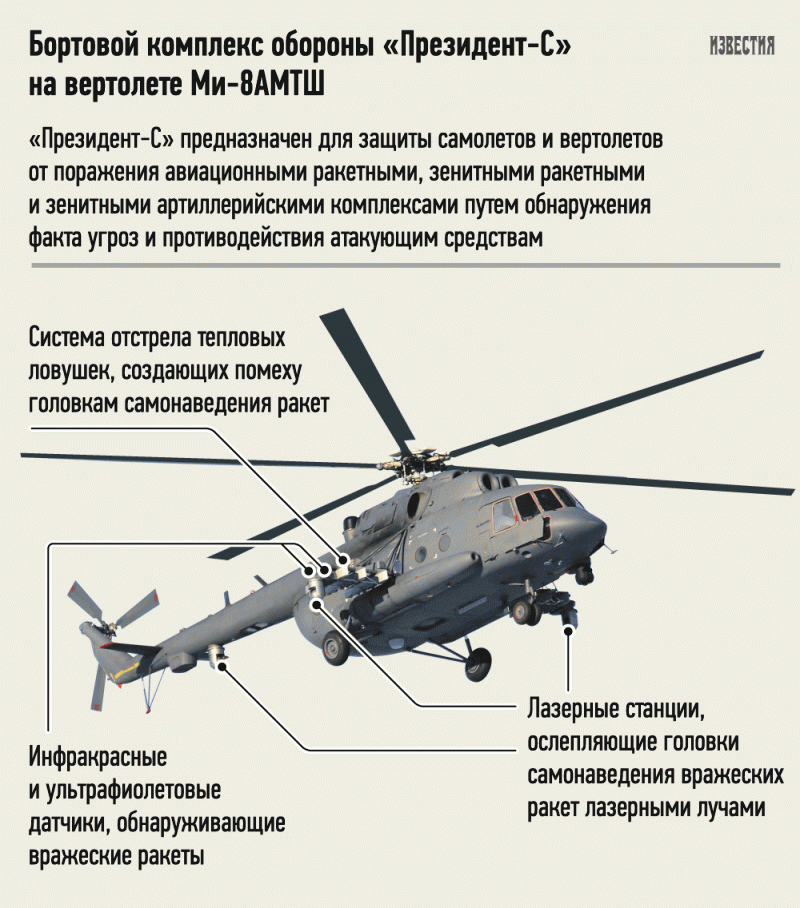
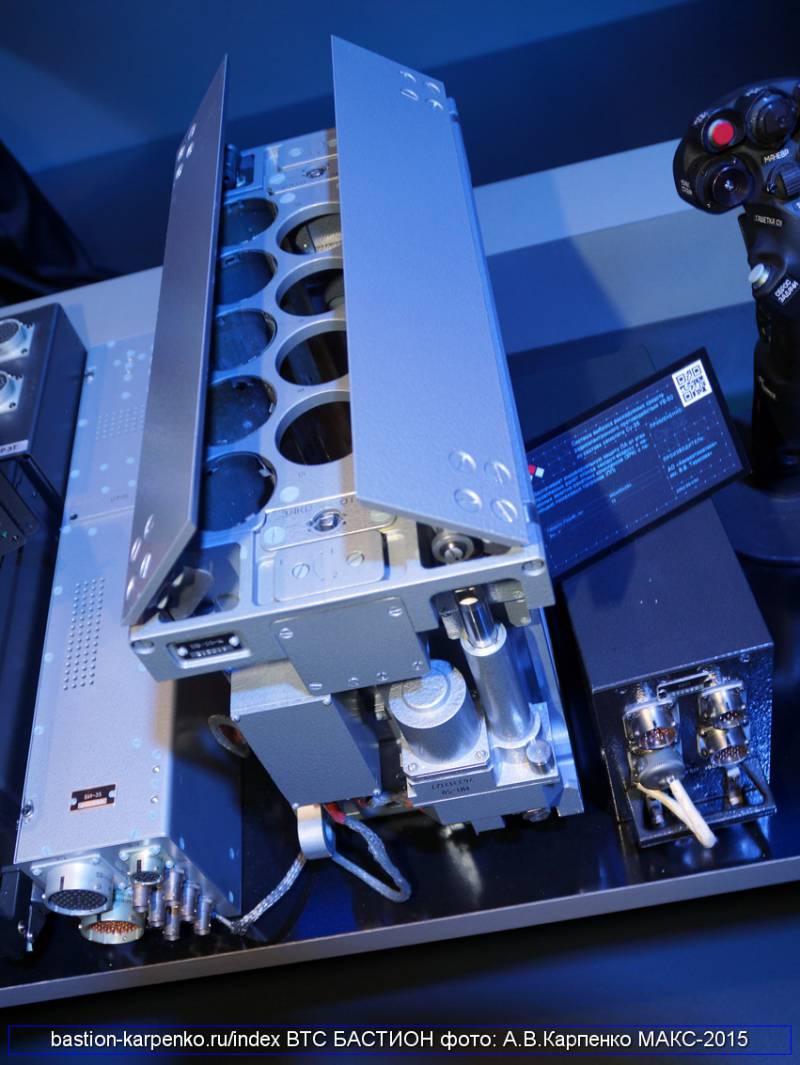
Information